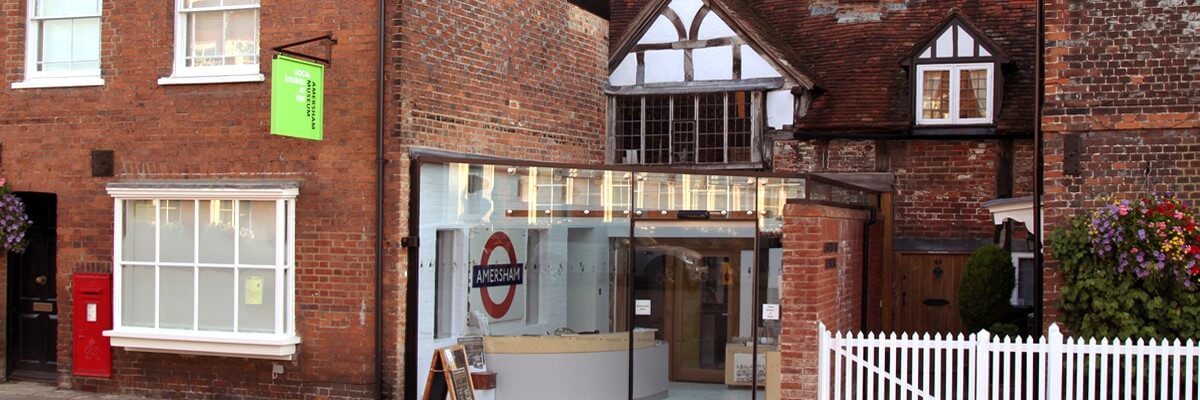This article has been written by Peter and Marian Borrows to say what would have been useful to them before setting out on the task of researching the history of their house in Amersham – see a separate page for what they discovered. There are also two very helpful articles by another contributor which explain how the Censuses in Amersham were organised and the way the town was split into districts;
Discovering the history of your house requires a certain amount of luck and a great deal of patience.
Useful resources may be found:
- on the internet, eg census records and some of the National Archives at Kew;
- at the Amersham Museum (a few);
- in the Amersham Public Library (a few)
- in the Buckinghamshire County Archives in Aylesbury.
The staff in the Search Room at Aylesbury are both helpful and knowledgeable, but to use it you will need a Reader’s Ticket, which can be issued on arrival, provided you bring a passport and bank statement or equivalent documents. Make sure you keep a good record of where you found a particular piece of information because you may well want to go back and check it as your story develops.
Census records should tell you who lived in the house between 1841 and 1911 (and usually their age, occupation, family relationships and place of birth) and this is a good place to start because you can make rapid progress – if you can identify your house. Paper copies of extracts are available in some libraries or full records are on-line at http://home.ancestry.co.uk/ or http://www.findmypast.co.uk/. You can pay-as-you-go, although some public libraries or family history centres have a subscription.
Maps are essential and the Aylesbury Archives hold:
- Various large-scale Ordnance Survey maps;
- The Drake sale map of 1928 (also at Amersham Museum);
- The Tithe Apportionment map of Amersham, 1839;
- A map of Agmondesham, 1742;
- Various more specific maps, eg of Shardeloes estate.
One possible way of locating your house is by counting along from the nearest inn, which can often be identified. But beware that inns open, close, change name and move location and that houses get joined and divided, buildings come and go, gaps get filled and created. We found it helpful to make several photocopies of one of these maps faintly in black and white on sheets of transparent film, and then colour them in / annotate them according to the information on the other maps or as we discovered it in archived documents. They could then be overlaid as a way of making comparisons over time. Many documents contain statements such as
a messuage situate between the property occupied by William Brown and the property owned by John Daveney (currently in the occupation of Edward Child)
so you need to build up a picture of who lived where and when for several of your neighbours in order to help trace your house over a period of time.
Once you have the maps, if you can identify your house, Land Tax records (mainly late 18th to early 20th century at the Aylesbury Archives) may allow you to discover the owner (not necessarily the occupier). Once you know an owner, you may be able to find the next owner – and perhaps the occupier – from the first owner’s will. Some wills are at Aylesbury, some are at the National Archives at Kew, some you will find by accident in amongst old deeds for a house.
In the end, for old houses, there will be no alternative to systematically going through archived original documents at Aylesbury – for Amersham, especially the various Drake family archives. Note that there are two sets of Drake archives – the main Drake archives and the Additional Drake archives (the latter were much the most useful for us). This will take many days travelling up blind alleys because the catalogues don’t give much detail. Written on vellum with a quill pen, often with wax seals at the bottom, you can sometimes feel the grains of sand used to dry the ink. Nearly all the ones we found were in English but the legal language is even more impenetrable than that used today and the script, especially for the 16th and 17th century indentures, can be very difficult to decipher. The earliest we read (or attempted to read) was from the reign of Edward VI. Aylesbury has a couple of useful books explaining the various legal terms.
Many other records (usually frustratingly incomplete) may be valuable, for example:
- Amersham parish registers from the 16th century onwards (in Aylesbury);
- The Amersham Parish Chest (in Aylesbury and Amersham Library);
- in the 18th century the tax paid on apprenticeships (at the National Archives at Kew, but available on-line);
- in the 19th and late 18th centuries the names of licensed victuallers (in Aylesbury);
- trade directories from the 19th & 20th centuries (in Aylesbury);
- for much of the 20th century, electoral registers (in Aylesbury) will tell you the occupants of voting age;
- your own conveyancing documents and solicitor’s search results.
Good luck!

